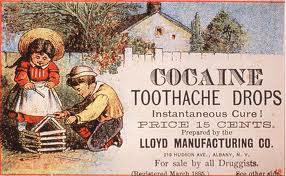
Painting © 2004 Loz
Arkle
Website
© Copyright 2000-2011 Alan White - All
Rights Reserved
Site optimised for Microsoft Internet Explorer
Lil McClintock, Blues and Medicine Shows |
|
This essay is taken from Mike Ballantynes's website www.mikeballantyne.ca . Mike has kindly agreed for me to publish it on the Earlyblues website. Thanks Mike.
Lil McClintock’s Don’t Think I’m Santa Claus [see Mike Ballantyne's transcription], however, is something of a departure from this. It is an excellent example (and one of the very few existing examples) of an early, twentieth century, medicine show singer’s song-medley, and one that belongs almost solely to, and is a direct product of the shows. It includes verses and/or choruses from four, quite separate, popular, published songs in a typical device designed to cover a large amount of material and attract, or keep the attention of a varied audience. Of the four songs that make up Don’t Think I’m Santa Claus, the title song is from You Must Think I’m Santa Claus, written by Irving Jones and Frank Silver. It was recorded by Bob Roberts in 1904 on Victor 4110, Matrix B-1768, and again the following year, on a wax cylinder, by Tascott (no forename). Tascott’s version can be heard on line at: http://www.archive.org/details/Tascott-YouMustThinkImSantaClaus1905. The running chorus (Lindy) is from By The Watermelon Vine, Lindy Lou, written by Thomas Allen and published in 1904. The two other fragments are from Keep A Little Cosy Corner in Your Heart for Me, by Jack Drislane and Theodore F. Morse, published in 1905, and Everybody Works But Father, by Jean Havez, also published in 1905, but based upon an English music hall standard We All Go To Work But Father.
The chorus of Everybody Works But Father (the first verse of the two included in Don’t Think I’m Santa Claus) survived well into the second half of the 20th century. Groucho Marks sang it in both English and German when he was a guest on a television programme, and the blues minstrel Jesse Fuller recorded it on his 1963 Fantasy recording Brother Lowdown, [released on CD as Fantasy FCD-24707-2]. Ken Romanowski, in his 1993 notes to Document Records CD Georgia Blues & Gospel (1927-1931) [DOCD-5160] suggests that ‘Lil’ was probably a shortened version of ‘Little’. However, although this may well have been the case, it was quite likely that it had the reverse meaning and that he was called ‘Lil’ either because was tall and thin or because he was a big man. An on-line video of Don’t Think I’m Santa Claus, can be found at: http://www.youtube.com/watch?v=g3j6ZCguSyE, sung by Dom Flemons. One of the notable things about his introduction to the song is that Flemons holds his hand so high (about four feet off the floor) to illustrate why McClintock is referred to as ‘Lil’. McClintock was from Clinton, South Carolina, near the birthplaces of both The Rev. Gary Davis and ‘The Carolina Bluesman’ Pink Anderson. Although McClintock’s voice was not recorded until 1930, he and his wife had been interviewed considerably earlier, in 1923, by Chapman J. Milling. At that time Milling collected a version of Delia Holmes, later better known as Delia or Delia’s Gone, and he published the words in the Southern Folklore Quarterly Vol. 1 No. 4 (December, I937, p. 3-7) under the subtitle of “A Neglected Negro Ballad”. Copyright Ó Mike Ballantyne 2010 __________________________________________________________________________ Mike Ballantyne
For further details see Mike's website www.mikeballantyne.ca __________________________________________________________________________
Website © Copyright 2000-2011 Alan White. All Rights Reserved. |








 The roots of the
blues are many and varied. The two most prominent genres from which they sprang
are Black folksongs, including both play-party songs and animal rhymes, and work
songs. Many of these latter songs evolved from the singing of railroad
track-lining gangs, sugarcane cutters, cotton pickers, road gangs, quarry and
mine workers and the like, commonly within the prison systems of the American
South and South West.
The roots of the
blues are many and varied. The two most prominent genres from which they sprang
are Black folksongs, including both play-party songs and animal rhymes, and work
songs. Many of these latter songs evolved from the singing of railroad
track-lining gangs, sugarcane cutters, cotton pickers, road gangs, quarry and
mine workers and the like, commonly within the prison systems of the American
South and South West.  This last song was
published under the banner of Lew Dockstader. Dockstader was a vaudevillian and
blackface minstrel who had his own minstrel troupe (with Al Jolson amongst its
alumni).
This last song was
published under the banner of Lew Dockstader. Dockstader was a vaudevillian and
blackface minstrel who had his own minstrel troupe (with Al Jolson amongst its
alumni).  Mike is a singer
who formerly sang folksongs, folk-blues and blues, together with some country
and jazz. Now, with more than forty years singing experience behind him, and to
the exclusion of all his previous repertoire, he is devoting himself exclusively
to early blues and, for the most part, to their earliest documented lyrics as
they were sung and recorded in the 1920’s and 1930’s. These blues, for the most
part, form a fun and varied repertoire of blues, hokum, ragtime and jug band
songs, rather different from stereotypical, often slow and rather maudlin
twelve-bar blues.
Mike is a singer
who formerly sang folksongs, folk-blues and blues, together with some country
and jazz. Now, with more than forty years singing experience behind him, and to
the exclusion of all his previous repertoire, he is devoting himself exclusively
to early blues and, for the most part, to their earliest documented lyrics as
they were sung and recorded in the 1920’s and 1930’s. These blues, for the most
part, form a fun and varied repertoire of blues, hokum, ragtime and jug band
songs, rather different from stereotypical, often slow and rather maudlin
twelve-bar blues. 